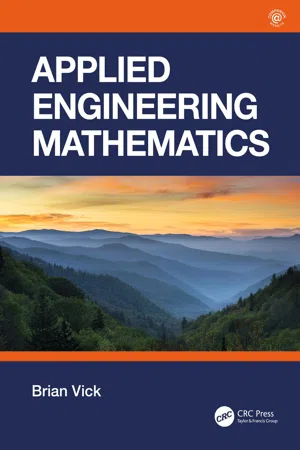
- 232 pages
- English
- ePUB (mobile friendly)
- Available on iOS & Android
Applied Engineering Mathematics
About This Book
Undergraduate engineering students need good mathematics skills. This textbook supports this need by placing a strong emphasis on visualization and the methods and tools needed across the whole of engineering. The visual approach is emphasized, and excessive proofs and derivations are avoided. The visual images explain and teach the mathematical methods. The book's website provides dynamic and interactive codes in Mathematica to accompany the examples for the reader to explore on their own with Mathematica or the free Computational Document Format player, and it provides access for instructors to a solutions manual.
-
- Strongly emphasizes a visual approach to engineering mathematics
-
- Written for years 2 to 4 of an engineering degree course
-
- Website offers support with dynamic and interactive Mathematica code and instructor's solutions manual
Brian Vick is an associate professor at Virginia Tech in the United States and is a longtime teacher and researcher. His style has been developed from teaching a variety of engineering and mathematical courses in the areas of heat transfer, thermodynamics, engineering design, computer programming, numerical analysis, and system dynamics at both undergraduate and graduate levels.
eResource material is available for this title at www.crcpress.com/9780367432768.
Frequently asked questions
Information
Chapter 1
Overview
- Objectives
- Educational philosophy
- Physical processes: conservation laws, rate equations, and property relations
- Mathematical models: algebraic equations, ordinary differential equations, and partial differential equations
- Solution methods for algebraic and differential equations
- Software
1.1 Objectives
- Physical Processes
To gain a fundamental understanding of the physical processes, fundamental principles, and mathematical formulations of physical problems. - Mathematical Methods
To learn mathematical techniques for solving model equations. - Software
To learn the use of software packages, such as Mathematica or MATLAB®, to program solutions, perform calculations, and create graphics. Computational studies and graphics enhance insight into the effect of important parameters in addition to building a fundamental understanding of physical mechanisms. - Insight and Critical Thinking
To develop a sound foundation for problem-solving using critical thinking, interpretation, and reasoning skills. Applications are used extensively to foster insight and intuition.
1.2 Educational Philosophy
- We learn by active participation, not by passive observation. That is, we learn by doing, not just by watching.
- A picture is worth a thousand words. The human brain is made to process visual information. More information can be assimilated in a few seconds by looking at graphics than by studying that same information for months from a printout of numerical values.
- We are all responsible for our own learning. You need to be self-motivated and have the desire to learn.
- Reasoning and interpretive skills—the foundation of problem-solving
- Pattern recognition skills
- Adaptability—learning to recognize abstract concepts from specific applications and conversely, learning to apply abstract concepts to specific applications
- Thinking for yourself
- Motivation, enthusiasm, and passion
1.3 Physical Processes
- The conservation laws are:
- Conservation of mass: continuity
- Conservation of mom...
Table of contents
- Cover
- Half-Title
- Title
- Copyright
- Contents
- Preface
- About the Author
- 1 Overview
- 2 Physical Processes
- 3 Modeling of Physical Processes
- 4 Calculus
- 5 Linear Algebra
- 6 Nonlinear Algebra: Root Finding
- 7 Introduction to Ordinary Differential Equations
- 8 Laplace Transforms
- 9 Numerical Solutions of Ordinary Differential Equations
- 10 First-Order Ordinary Differential Equations
- 11 Second-Order Ordinary Differential Equations
- Index